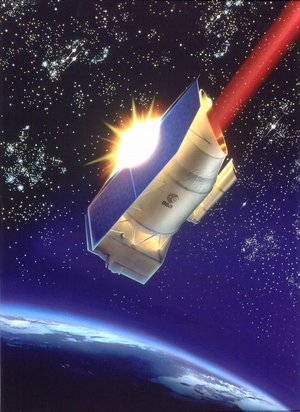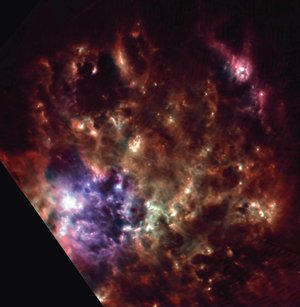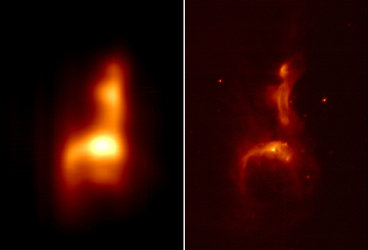Galaxies near and far from AKARI
Two new sets of observations from the AKARI Infrared Space Telescope, JAXA mission with ESA participation, show how the spaceborne telescope has investigated galaxies both near and far.
In the first set, Toyoaki Suzuki, University of Tokyo, observed M101, a spiral galaxy
AKARI observed the galaxy at four infrared wavelengths (65, 90, 140, and 160 micrometres) using the Far-Infrared Surveyor (FIS) instrument. Many young high-temperature stars populate the spiral arms, revealing the areas of star formation and warming the interstellar dust. This causes the galaxy to shine at shorter infrared wavelengths. In contrast, the longer wavelengths show where the ‘cold’ dust is located. Normal stars, typically like our own Sun, warm this dust.

FIS data was compared to an image of the galaxy in the visible and far-ultraviolet. It shows that the warm dust is distributed along the spiral arms, with many hot spots located along the outer edge of the galaxy. These spots correspond to giant star-forming regions. This is unusual because star formation is generally more active in the central parts of spiral galaxies.
The evidence points to M101 having experienced a close encounter with a companion galaxy in the past, dragging out gas from the hapless companion. The gas is now falling onto the outer edge of M101 at approximately 150 km/s, triggering the active star formation.

AKARI has also been observing galaxies in the far distant Universe to address one of the most important questions in modern astronomy: how did the galaxies evolve into their current form?
To help find the answer, Shuji Matsuura and Mai Shirahata, ISAS/JAXA, used AKARI to carry out one of the most extensive observations ever made in the far-infrared, detecting many faint galaxies in the distant Universe at FIR’s four wavebands. This wavelength information is essential to investigate the mechanisms responsible for the emission of infrared light and to estimate the distances to the galaxies.

The white spots in these images are all faint galaxies of different brightnesses. They imply that ordinary galaxies seen in the present time shone much more brightly in the infrared when they were younger. In many cases this is due to explosive episodes of star birth during earlier times. Some galaxies appear to have a differing brightness at different wavelengths than others and it is suspected that this might be because these galaxies are brightened by the energy released from a black hole at their cores.
The AKARI data shows that the number of galaxies increases rapidly as they appear fainter and so indicates that the galaxies have merged. However, they do not seem to evolve as drastically as inferred by previous observations. As AKARI’s are the most sensitive observations ever made at these wavelengths, this result suggests that a new galaxy evolution model may be necessary.
Note for editors:
AKARI was launched on 21 February 2006 and began its scientific observations in May 2006.
Its on-board supply of liquid helium ran out on 26 August 2007, and the spacecraft entered a new mission phase. The liquid helium was required to keep AKARI cold enough to observe in the far-infrared. The ‘warm’ phase will now use the surviving instruments, which can operate under the warmer conditions provided by the on-board mechanical coolers, for near-infrared observations.
AKARI achieved its planned ‘cold’ lifetime of 550 days. During this time, it conducted an infrared All-Sky Survey, covering about 94 % of the entire sky, with larger wavelength coverage and better spatial resolution than its predecessor, IRAS. It has performed mid-infrared surveys and carried out more than five thousand individually pointed observations.
AKARI is a JAXA mission carried out with the participation of several partners such as: the Nagoya University, The University of Tokyo and National Astronomical Observatory Japan; the European Space Agency (ESA); Imperial College London, the University of Sussex and The Open University (UK); the University of Groningen/SRON (The Netherlands); the Seoul National University (Korea). The far-infrared detectors were developed under collaboration with the National Institute of Information and Communications Technology (Japan).
ESA’s Operations Centre (ESOC) in Darmstadt, Germany, is providing the mission with ground support through its ground station in Kiruna, for several passes per day. ESA’s European Space Astronomy Centre (ESAC), Madrid, Spain provides expertise and support for the sky-survey data processing through the pointing reconstruction – this allows the determination of accurate astronomical positions for each of the sources detected. The goal is to accelerate the production of the survey catalogues as a legacy for Herschel and Planck.
ESAC also provides user support for the European astronomers who have been granted observing opportunities. The 10% of observing time obtained from this collaboration resulted in 400 observations covering various fields of astronomy, from comets to cosmology. The Call for observing opportunities in the warm phase is expected for next Spring.
For more information:
Alberto Salama, ESA Akari Project Scientist
Email: Alberto.Salama @ esa.int













